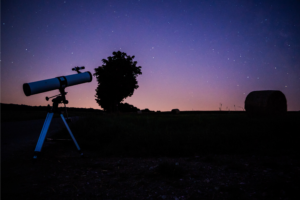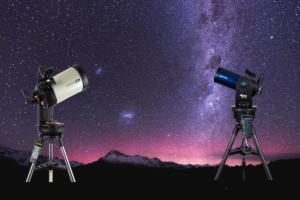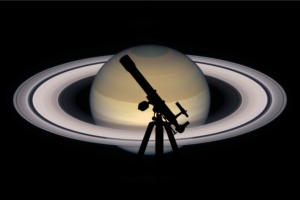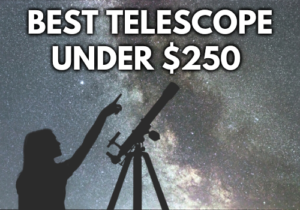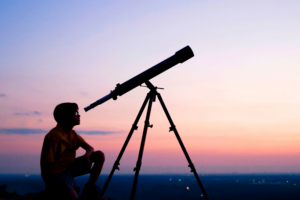Best Telescope Under $500 (2025); Reviews
Disclosure: This post contains affiliate links and I may earn a small commission (at no extra cost to you) if you click through and make a purchase. Thanks in advance – I really appreciate it!
Our comprehensive review of the best telescope under $500 will introduce you to 9 amazing affordable telescope models that will allow you to explore galaxies along the magnificent Milky Way, give you the ability to surf the stars, and explore spaces in the universe that a normal eye cannot see.
COMPARISON TABLE
| Image | Title | Best For | Features | Price | Buy |
|---|---|---|---|---|---|
 Top
Top
Top
Top
Top
Top
Top
Top
Top
Top | Celestron - AstroMaster 130EQ | Best Astronomy Telescope | Type: Reflector, Aperture: 130 mm(5.1″), Focal length: 650mm, Focal Ratio: f/5 | See on Amazon | |
 Top
Top
Top
Top
Top
Top
Top
Top
Top
Top | Gskyer Telescope, 600x90mm AZ | Best For Smartphone Astrophotography | Type: Refractor, Aperture: 90mm(3.5”), Focal length: 600mm, Focal Ratio: f/6.7 | See on Amazon | |
 Top
Top
Top
Top
Top
Top
Top
Top
Top
Top | Celestron - PowerSeeker 127EQ | Best For Beginners | Type: Reflector, Aperture: 127 mm(5″), Focal length: 1000mm, Focal Ratio: f/8 | See on Amazon | |
 | Celestron – StarSense Explorer LT 80AZ Smartphone App-Enabled | Best Smartphone enabled | Aperture: 80 mm (3.25"), Focal Length: 900 mm, Focal Ratio: f/11.3 | See on Amazon | |
 | Gskyer 130EQ Reflector | Best Refractor | Aperture: 130 mm, Focal length: 650 mm | See on Amazon | |
 | SOLOMARK 130EQ Newtonian Reflector | Best For the Moon | Aperture: 130mm (5.11″), Focal length: 650mm (25.6″), Focal ratio: f/5 | See on Amazon | |
 Top
Top
Top
Top
Top
Top
Top
Top
Top
Top | Orion 09007 SpaceProbe 130ST | Best Reflector | Type: Reflector, Aperture: 130 mm(5.1″), Focal length: 650mm, Focal Ratio: f/5 | See on Amazon |
Product prices and availability are accurate as of the date/time indicated and are subject to change. Any price and availability information displayed on [relevant Amazon Site(s), as applicable] at the time of purchase will apply to the purchase of this product.
Prices pulled from the Amazon Product Advertising API on: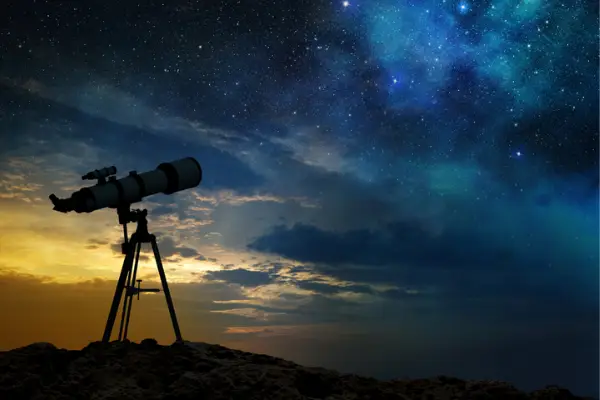
Best Telescope Under $500 Reviews
Best Astronomy Telescope
Celestron – AstroMaster 130EQ
- Type: Reflector
- Aperture: 130 mm(5.1″)
- Focal length: 650mm
- Focal Ratio: f/5
- Mount: Equatorial
- Eyepiece: 20mm, 10mm
- Magnification: 32.5x, 65x
- Weight: 28.0 lbs.(12.7 kg)
- Our Rating: 9.2/10
Prices pulled from the Amazon Product Advertising API on:
Product prices and availability are accurate as of the date/time indicated and are subject to change. Any price and availability information displayed on [relevant Amazon Site(s), as applicable] at the time of purchase will apply to the purchase of this product.
The telescope is fitted with a 1.25 rack-and-pinion focuser and two eyepieces to get new users started – a 10mm that yields 65x power and a 20mm for a 32.5x magnification.
The 20mm eyepiece integrates an erecting system to correct images horizontally and vertically to allow easy terrestrial use.
The AstroMaster 130EQ also features an unmagnified red-dot finder to help set-up, align and navigate easier.
Celestron’s AstroMaster 130EQ 130mm f/5 Reflector Telescope features a 650mm focal length and an oversized parabolic mirror that produce detailed images of the Moon, clear views of the planets, and the ability to resolve distant objects such as nebulae and galaxies.
The 130EQ comes on a lightweight German equatorial mount that works well enough for the 130 mm f/5 OTA, and it should work okay with a DSLR camera piggybacked on top.
Since it can get quite hard to keep the object in the view because of the Earth’s rotation, there is an upgrade for this mount to help you with that.
It is a simple clock motor which you turn on after you get the object in the view and it will track the object keeping it in the middle of the eyepiece. It’s much easier to stargaze like this rather than twisting the knobs while looking through the eyepiece. The motor is not included but it can be bought separately.
At just 17 lbs total weight and thanks to its compact design, the Celestron AstroMaster 130 EQ is very portable. You can take it literally everywhere with you, unlike heavier and bulkier telescopes for professional use.
Pros:
- Very good optics
- Decently priced telescope
- Suitable for beginners as well as advanced users
- Clear crisp mirrors
Cons:
- Focuser is of limited usability
- No filters included
Best For Smartphone Astrophotography
Gskyer Telescope
- Type: Refractor
- Aperture: 90mm(3.5”)
- Focal length: 600mm
- Focal Ratio: f/6.7
- Mount: Altazimuth Mount
- Eyepiece: 25mm,10mm,5mm
- Magnification: 24x, 60x, 120x
- Weight: 18 lbs. / 8.2 kg
- Our Rating: 9.2/10
Prices pulled from the Amazon Product Advertising API on:
Product prices and availability are accurate as of the date/time indicated and are subject to change. Any price and availability information displayed on [relevant Amazon Site(s), as applicable] at the time of purchase will apply to the purchase of this product.
This is a great starter telescope for the explorer who intends to take their telescope with them on their journeys. Hiking, camping, and even moonlit fishing trips will be more fun when you have this telescope along with you.
If you live in the city and you aren’t able to see much of the sky due to light pollution, you’ll want a telescope like this that’s easy to carry with you.
Many users of this scope say that the Gskyer AZ90600 is the best telescope under $500 especially for viewing the planets.
The 90 millimeter aperture is perfect for viewing most of the things you’d want to view, and all of the glass optics are coated to automatically adjust the brightness of the stars to a level safe and comfortable for observation.
It also comes with a smartphone adapter, which allows you to use the phone as a screen, or as a camera to take great pictures.
Plus, this model is extremely easy to assemble and doesn’t require any calibration. If you’re a telescope beginner, you won’t have to worry about any tricky steps or complicated tests.
The Gskyer AZ90600 comes with an adjustable tripod. This adjustable aluminium tripod offers the viewer many different viewing positions. The height of the aluminum tripod can be adjusted from about 31.5-inch to 49-inch.
If you’ve never owned a telescope before, This 90mm (3.5″) aperture gives bright, sharp images for both land and celestial objects.
Whether you’re viewing the rings of Saturn, the moons of Jupiter, surface details on the Moon, or terrestrial objects, the Infinity 90 Refractor allows the amateur astronomer to explore the solar system and beyond.
Pros:
- Large aperture
- 3 eyepieces
- Smartphone adapter
- Easy to assemble and use
- Adjustable tripod
- Perfect travel telescope
Cons:
- Good for viewing planets, stars not so much
Best Beginner Telescope
Celestron – PowerSeeker 127EQ
- Type: Reflector
- Aperture: 127 mm(5″)
- Focal length: 1000mm
- Focal Ratio: f/8
- Mount: German Equatorial
- Eyepiece: 20mm, 4mm
- Magnification: 50x, 250x
- Weight: 22.0 lbs.(10.0 kg)
- Our Rating: 9/10
Prices pulled from the Amazon Product Advertising API on:
Product prices and availability are accurate as of the date/time indicated and are subject to change. Any price and availability information displayed on [relevant Amazon Site(s), as applicable] at the time of purchase will apply to the purchase of this product.
The Celestron PowerSeeker 127EQ telescope is a Newtonian reflector, which means it uses mirrors to gather the light of the skies, and reflects it for viewing. With mirrors being much less expensive to produce than glass lenses, reflector telescopes offer more value in terms of inches of aperture.
The PowerSeeker 127EQ comes with two eyepieces (4mm and 20mm) and a 3x Barlow lens.
The 5-inch mirror on the 127mm PowerSeeker model limits useful magnification to about 250x, which is achieved using the 4mm eyepiece.
The larger 20mm eyepiece provides a more useful 50x magnification. This grows to 150x when coupled with the 3x Barlow.
If you’re considering an additional eyepiece, something like a 15mm Plossi would be a good option. This provides you with 66x magnification, or 198 when coupled with the Barlow.
The telescope is ideal for near and deep-sky observation, Celestron’s PowerSeeker 127EQ 127mm f/8 Reflector Telescope features a respectable focal length and a large, parabolic mirror that produce detailed images of the Moon, clear views of the planets, and the ability to resolve bright distant objects such as nebulae and galaxies.
The beauty of a Newtonian telescope is the longer focal lengths which can be offered in much shorter tube sizes—1000mm focal length in a tube which is only 20 inches (508mm) long .
The PowerSeeker 127EQ is highly portable and one of the best travel telescopes under $500. You could easily fit this telescope and tripod in the trunk of a car and still have room for your other equipment, or maybe a late night picnic.
This telescope comes with an Equatorial mount, designed for astronomy telescopes. Included are two manual slow-motion controls, these allow for smoother tracking of objects as they pass across the night sky.
The tripod is made of aluminum, although lightweight, it is robust, solid and also comes with a very handy accessory tray which lets you keep extra eyepieces and T-rings for a camera, close to hand.
Pros:
- Solid build quality
- Stable mount
- Comes with a 3x Barlow lens
Cons:
- Spherical mirror leads to some amount of aberrations
- Occasional collimation of the mirrors required
Best App Enabled
Celestron – StarSense Explorer LT 80AZ
- Optical Design: Doublet Refractor
- Aperture: 80 mm (3.25)
- Focal Length: 900 mm
- Focal Ratio: f/11.3
- Mount: Alt Azimuth
- Highest Magnification: 160x
Prices pulled from the Amazon Product Advertising API on:
Product prices and availability are accurate as of the date/time indicated and are subject to change. Any price and availability information displayed on [relevant Amazon Site(s), as applicable] at the time of purchase will apply to the purchase of this product.
The StarSense Explorer LT 80AZ is the perfect telescope for a family, for a classroom, or for anyone who doesn’t want to invest too much at the start.
The telescope takes advantage of a smartphone app that helps it locate objects in the sky, a kind of telescope that is growing in popularity among buyers.
It comes with two 25mm and 10mm eyepieces, and a full-sized tripod, which can be toggled to different heights. That’s a perfect solution for families as it can grow with children as they get older too.
The 80mm aperture of this telescope can gather enough light for major Solar System details and exceptionally bright deep space objects.
Jupiter shows its Galilean Moon’s, and on ideal conditions and with a premium eyepiece, its stripes, and The Great Red Spot.
Saturn appears as a bright disk, and its Rings are distinguishable from the planet.
The Moon is the best target to observe with a long refractor.
The telescope is also quite lightweight, just 9.2 pounds. That makes it easy to move around, meaning you can take this from inside a house to a car, to a backyard to a school, without needing help.
The tripod folds up easily, and the telescope also never felt in danger of falling or tipping over once it was tightened down.
The selling point for the StarSense Explorer LT is how it is paired with an app.
Once the telescope is paired with the app, you can aim the telescope into the sky and the app will pick up on things, while also naming what you’re looking at with your eye.
The app will let you know objects that are viewable every night, when they’re rising and setting, and where in the sky they’re located.
The app also highlights objects that are best seen in dark skies.
The telescope also works like any other telescope without a smartphone attached to it.
Pros:
- Good for beginners
- Sturdy and lightweight
- The app works really well
- Perfectly portable
Cons:
Takes time to sync smartphone app to telescope
Best Refractor
Gskyer 130EQ Reflector Telescope
- Aperture: 130 mm
- Focal length: 650 mm
- Field of view: 1.5°
- Main mirror length: 609.6mm
- Finderscope: Red dot finder
- Dimensions 32 x 18 x 8 inches
- Item Weight 34 pounds
Prices pulled from the Amazon Product Advertising API on:
Product prices and availability are accurate as of the date/time indicated and are subject to change. Any price and availability information displayed on [relevant Amazon Site(s), as applicable] at the time of purchase will apply to the purchase of this product.
The Gskyer Astromaster 130EQ telescope is the very definition of versatility. No matter if you’re a beginner or a seasoned astronomer, the Astromaster 130EQ has everything you’ll need to start your journey among the stars.
The Gskyer Astromaster 130EQ telescope has a 130mm aperture, with a total focal length of 650mm, and a focal ratio of f/5. Moreover, in terms of optics, the Astromaster 130EQ comes equipped with 3 different eyepieces.
There is a low (25 mm) which magnifies 40x, medium (10 mm) which magnifies 100x, and high (5 mm) which magnifies 200x.
Other than that, there is a 3x Barlow lens which provides the best accuracy in a telescope.
The AstroMaster 130EQ Professional Reflector Telescope comes with an equatorial mount, a stainless steel tripod, and an accessory tray for keeping all the other things.
The tripod is a multifunctional one that can enhance your view from certain angles. Multi Antireflection Blue Film has been used for optical coating bringing enhanced image brightness along.
Due to its advanced design and features, the Gskyer Astromaster 130EQ is recommended for both celestial and terrestrial observations.
With this telescope, you will be able to see the Moon’s seas, the ring of Saturn, the moons of Jupiter, as well as track fast-moving celestial objects such as comets.
Pros:
- Crystal clear view
- Excellent quality
- Sturdy construction
- Various accuracy levels
- Warranty provided
Cons:
- The counterweight can sometimes be cumbersome.
- The telescope is heavy and hard to move around.
Best For The Moon
SOLOMARK 130EQ Newtonian Reflector
- Telescope type: Reflector
- Aperture: 130mm (5.11″)
- Focal length: 650mm (25.6″)
- Focal ratio: f/5
- Weight: 15.1 Kg (33.4 lb)
- Maximum magnification: 260x
- Included eyepieces:10mm, 20mm
- Accessories:1.5x Barlow lens, moon filter, phone adapter
Prices pulled from the Amazon Product Advertising API on:
Product prices and availability are accurate as of the date/time indicated and are subject to change. Any price and availability information displayed on [relevant Amazon Site(s), as applicable] at the time of purchase will apply to the purchase of this product.
The Solomark Polaris 130EQ is a solid telescope with great optics at an incredible price.
If you are a first-time buyer looking to get into the hobby you will learn a lot with this telescope and will definitely enjoy it.
Setting up the telescope takes a bit of time, but it’s relatively simple.
The tripod is made of aluminum and while it doesn’t feel as premium as stainless steel, it’s good enough and it keeps it from being too heavy.
The optical tube is made out of carbon fiber which makes it lighter and gives it a beautiful and elegant black finish.
The optics of the Polaris 130EQ are great. The lenses are high quality and the light transmission produces bright and colorful images.
A telescope in this aperture range is ideal for lunar and planetary viewing. You will be able to recognize the mounts and geology of the Moon with a high level of detail.
Mars is also a great target, and the characteristic elements of other planets like Saturn’s ring are no problem.
The telescope is good for showing you brighter deep space objects too.
The 130mm aperture will allow you to go to a maximum useful magnification of 260x approximately. If you are interested in astrophotography, this is an excellent telescope to start with.
The telescope comes with two Kellner eyepieces, a 10mm and a 20mm, as well as a generic 1.5x Barlow lens.
These eyepieces combined with the Barlow will give you access to the following magnifications: 32.5x, 43x, 65x, and 86x.
It also comes with a Moon filter and a smartphone adapter out of the box
Pros:
- Great optics
- Good accessories
- Great views of the planets and the moon
- Limited astrophotography
- Affordable
Cons:
- Bit of a learning curve
- Not kid friendly
Best Reflector Pick
Orion 09007 SpaceProbe
- Type: Reflector
- Aperture: 130 mm(5.1″)
- Focal length: 650mm
- Focal Ratio: f/5
- Mount: Equatorial
- Eyepiece: 25mm, 10mm
- Magnification: 26x, 65x
- Weight: 24.2 lbs.(11 kg)
- Our Rating: 9/10
Prices pulled from the Amazon Product Advertising API on:
Product prices and availability are accurate as of the date/time indicated and are subject to change. Any price and availability information displayed on [relevant Amazon Site(s), as applicable] at the time of purchase will apply to the purchase of this product.
The Orion SpaceProbe 130ST Newtonian Reflector is an excellent and one of the best telescope under $500. It is well-suited for both beginners as well as intermediate stargazers.
The SpaceProbe 130ST is a 130mm f/5 Newtonian reflector telescope.
This 5.1″ aperture reflector telescope gathers an ample amount of light for great views of the planets and Moon, as well as brighter galaxies, nebulas, and star clusters
The telescope also comes with tools to help you assemble the product, and two eyepieces: 10mm for 65x, and a 25mm for 26x magnification, respectively.
The quick set-up and ease of use makes the SpaceProbe 130ST EQ a very versatile telescope which the whole family can enjoy.
This Orion space probe telescope also boasts a short 24″ long optical tube design which enhances its portability, while the 130mm optical diameter, and the 650mm focal length are in perfect balance with the f/5.0 focal ratio.
In addition, it possesses design features, such as a parabolic mirror and a specially designed holder for the secondary mirror, that focus the light captured by the aperture and use it to sharpen the images produced by the scope, even with its shorter tube.
The included aluminium tripod is very sturdy, and also includes an accessory tray that can be very useful when you are outdoors in the dark and need a place to organize your accessories neatly.
Pros:
- Nice set of accessories
- Can be upgraded to have motorized tracking
- Comes with an Equatorial mount and a versatile tripod
- Easy to assemble and transport
Cons:
- Plastic focuser and mount parts
- Somewhat confusing instructions
Buying Guide: How To Choose A Telescope Under $500
Telescopes are an incredible door to the heavens, for anybody intrigued by space and astronomy.
Telescopes are an incredible door to the heavens, for anybody intrigued by space and astronomy and is willing to investigate the unending immensity of the world. If you are looking for the best telescope under $500 then you are bound to encounter a wide variety of choices. The telescopes for under $500 are ideal for amateurs to intermediates to advanced as well.
A telescope in this price range will enable you to view planetary details like shadows and texture of the moon, nebulae and galaxies, among other objects.
There is a big variation between telescopes used for watching mountains and cities, than those for watching the Moon and neighbouring planets, or the ones for deep space exploration.

What is generally important are good optics for a clear view especially if you are someone interested in astrophotography paired with a stable and secure stand as well.
One common misconception is that telescopes are meant to magnify small objects. The objects in space are certainly not small – they are enormous.
They only appear small to us. And if we only magnify what we can see with our eyes, we would simply get a big smudge with a distorted picture. Imagine this scenario as zooming into a low-quality picture.
What is important is the gathering light capability, the size of the aperture This will allow us to see more details – only then the magnification actually makes sense.
So, while magnifying power is important, it relies on a more significant feature – objective diameter, or aperture.
A bigger aperture allows for greater magnification. But keep in mind that magnification also depends on the focal ratio.
So if you want to look at smaller details with a bigger magnification, you might want to use slow telescopes with a high f-number, instead if you want a wide field of view with lots of stars and galaxies, a fast telescope with a low f-number is a better choice.
Finally, make sure to always double check whether or not your telescope under $500 (it should) comes with a stand because some models do ship without a stand and mount.
You can also consider telescopes with GoTo Mounts, these will help you guide the telescope automatically with a handheld computer.
Features To Look For In A Telescope Under $500
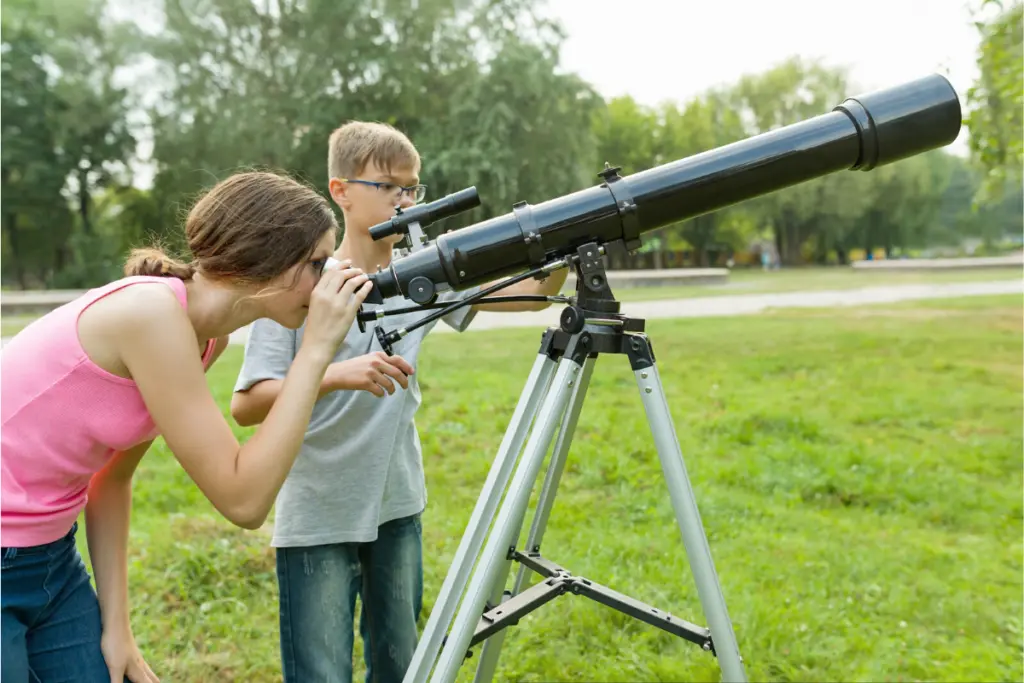
Type Of Telescope
The telescopes, for all their varied shapes and sizes, types of telescopes can be divided into three classes: refractors, reflectors, and catadioptrics.
1. Refractor Telescope
The refractor telescope uses a lens to gather and focus light. The first telescopes built were refractors. The glass lens is at the front of the telescope and light is bent (refracted) as it passes through the lens.
Refractor telescopes are rugged. After the initial alignment, their optical system is more resistant to misalignment than the reflector telescopes.
The glass surface inside the tube is sealed from the atmosphere so it rarely needs cleaning.
Since the tube is closed off from the outside, air currents and effects due to changing temperatures are eliminated. This means that the images are steadier and sharper than those from a reflector telescope of the same size.
All refractors suffer from an effect called chromatic aberration (“color deviation or distortion”) that produces a rainbow of colors around the image. Because of the wave nature of light, the longer wavelength light (redder colors) is bent less than the shorter wavelength light (bluer colors) as it passes through the lens.
2. Reflector Telescope
The second type of telescope, the reflector telescope, uses a mirror to gather and focus light. Its most common form is the Newtonian reflector, with a specially curved concave primary mirror in the bottom end of the telescope.
Near the top a small, diagonal secondary mirror directs the light from the primary to the side of the tube, where it’s met by a conveniently placed eyepiece.
If you want the most aperture for your money, the reflector is the scope for you.
When well made and maintained, a reflector can provide sharp, contrasty images of all manner of celestial objects at a small fraction of the cost of an equal-aperture refractor.
3. Catadioptric Telescope
The third type of telescopes are the catadioptric or compound telescope. These were invented with the desire to combine the best characteristics of refractors and reflectors: they employ both lenses and mirrors to form an image.
The greatest appeal of these instruments is that, in their commonly encountered forms (the Schmidt-Cassegrain and Maksutov-Cassegrain), they are very compact.
Their tubes are just two to three times as long as wide, an arrangement allowed by “optical folding” of the light. The smaller tube can use a lighter and thus more manageable mounting. The upshot is that you can obtain a large-aperture, long-focus telescope that’s very transportable.
Aperture
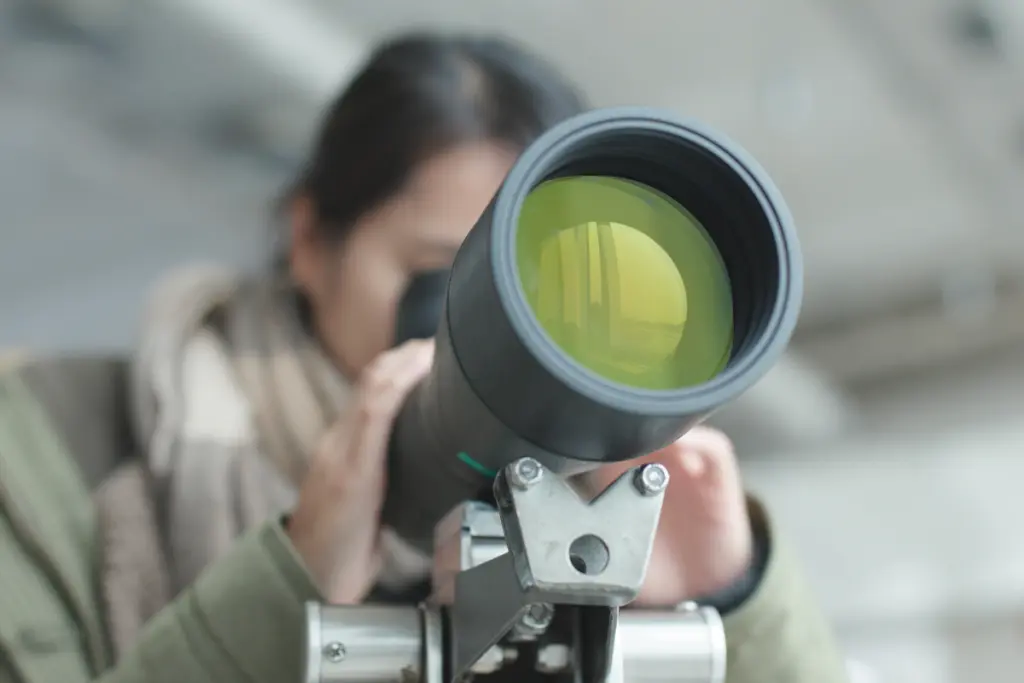
The most important aspect of any telescope is its aperture, the diameter of its main optical component, which can be either a lens or a mirror.
A scope’s aperture determines both its light-gathering ability (how bright the image appears) and its resolving power (how sharp the image appears). When learning how to choose a telescope, knowing all you can about the aperture is crucial to your ability to see the night sky.
This simply means – the bigger the aperture the better. With a 6-inch telescope you can discern craters on the Moon as small as about a mile across — half the size of those visible in a 3-inch scope (under the same conditions using the same magnification).
The same two instruments turned toward a faint galaxy on a moonless night would tell an even more dramatic story. Because the surface area of a 6-inch mirror is four times that of a 3-inch mirror, it collects four times as much light, meaning the galaxy would appear four times brighter.
Focal length
Focal length is the distance from the main optical component where light is gathered to the point where it is brought to a focus for the eyepiece to form an image. This obviously influences the level of magnification. A long focal length has higher magnification but offers narrower fields of view than a short one. It is suitable for objects that are closer like the moon, stars and planets.
To observe distant galaxies, choose a telescope with a short focal length and large diameter that provide wider and brighter views.
Focal length is closely associated with focal ratio which is denoted by f/number. Focal ratio is the focal length divided by the aperture diameter.
A ratio of f/11 to f/15 will have high magnification and narrow fields of view while a ratio of f/4 or f/5 will have lower magnification, brighter images and wider fields of view suitable for dim and distant objects.
Mounts
The best telescope in the world is useless unless it’s on a solid, stable, smoothly-working mount, one that permits it to be directed to the desired part of the sky and to follow a celestial object smoothly and precisely as the Earth turns beneath it.
Investing in a good mount will give you years of use even after you have upgraded your telescope.
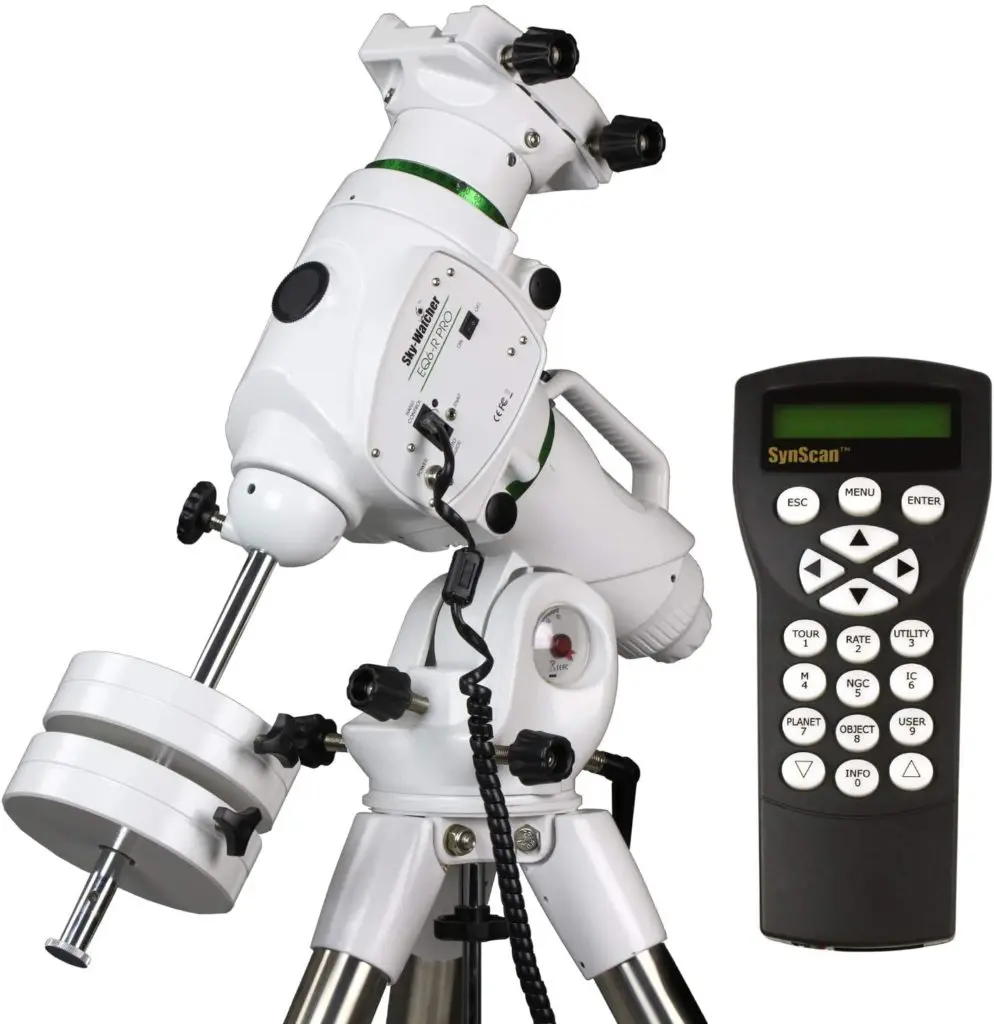
Altazimuth and equatorial are the two most common types of mounts.
1. Altazimuth Mounts
An equatorial mount should be used for a telescope intended for astronomy, and for which astrophotography is a future prospect, the equatorial mount here automatically counteracts Earth’s rotation.
It’s far easier to track a celestial object with a scope mounted this way, since you need only concern yourself with turning the scope about one axis — not two simultaneously, as in the alt-az. When an equatorial mount is properly set up, turning the slow-motion control of its polar axis is all that’s required to keep an object in view.
2. Equatorial Mounts
An equatorial mount should be used for a telescope intended for astronomy, and for which astrophotography is a future prospect, the equatorial mount here automatically counteracts Earth’s rotation.
It’s far easier to track a celestial object with a scope mounted this way, since you need only concern yourself with turning the scope about one axis — not two simultaneously, as in the alt-az. When an equatorial mount is properly set up, turning the slow-motion control of its polar axis is all that’s required to keep an object in view.
Eyepieces
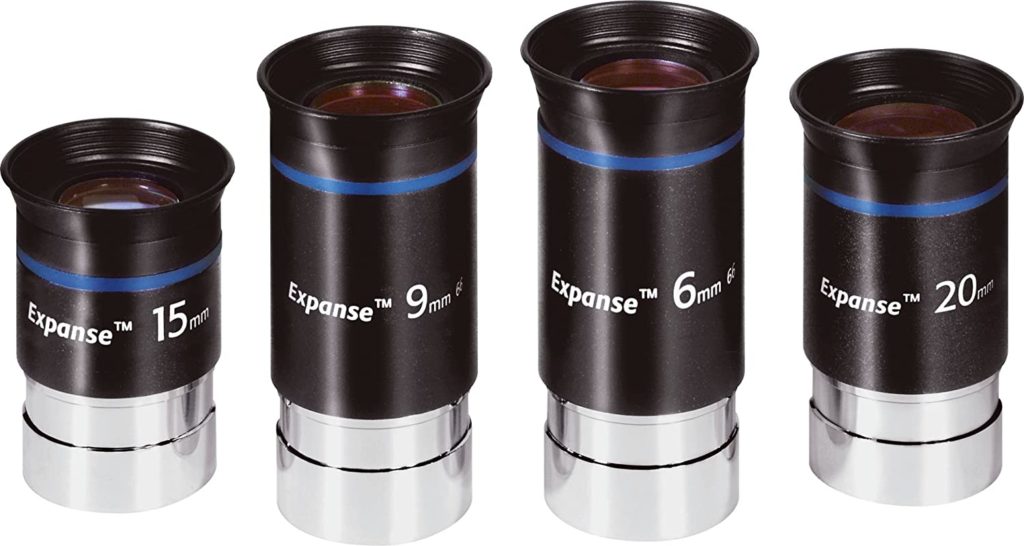
Eyepieces determine the magnification and field of view of a telescope. Different eyepieces are used to view different objects.
Some objects, such as nebulae and star clusters, appear quite large and are best viewed at low magnifications (which give a wider field of view), whereas planets appear very small and are normally viewed with high-magnification eyepieces.
One of the most common misconceptions in amateur astronomy is that magnification is the most important aspect of a telescope.
In reality, the diameter (aperture) of a telescope determines its power and different eyepieces are used to get the best view of a given object. Often the best view is at a low magnification.
There are two standard sizes of telescope eyepieces. The sizes are determined by the diameter of the eyepiece barrel that fits into the telescope. The two standard sizes are 1.25″ and 2″.
Weight
The size and weight of the telescope you are willing to carry is probably the biggest problem one must ponder.
Telescopes can range from around 15 lbs. to well over 300 lbs. Most can be broken down into 3 subsections for transportation: the optical tube assembly, the telescope mount, and the tripod or base. Remember, if the scope is too heavy, you may not use it at all.
Magnification
The magnification (power) of a telescope is variable and depends upon the eyepieces one uses. The power is computed by dividing the focal length of the primary objective (aperture) of the telescope by the focal length of the eyepiece being used.
Other Features
It is also important that you consider extra features such as accessories, warranty, instructional DVDs, and more.
Additional features might also include softwares such as StarryNight as in Orion 09007 and SkyX in Celestron NexStar 127SLT, an accessory tray or an extra 3rd eyepiece as with Gskyer AZ90600.
A database of celestial objects, instructional DVDs or Barlow lenses are other accessories that you should look for in a telescope under $500.
Conclusion
Our top pick for the best telescope under 500 dollars is the Celestron’s AstroMaster 130EQ 130mm f/5 Reflector Telescope that features a 650mm focal length and an oversized parabolic mirror that produce detailed images of the Moon, clear views of the planets, and the ability to resolve distant objects such as nebulae and galaxies.




